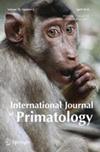Activity Budget and Sociality of the Northern Lesser Galago, Galago senegalensis
IF 1.8
3区 生物学
Q1 ZOOLOGY
引用次数: 0
Abstract
Abstract Complex sociality in primates often is argued to have evolved after the appearance of diurnal activity. Studying the behaviour of nocturnal primates is fundamental to understanding the evolutionary origins of primate behaviour and ecology, yet much less is known about the nature of sociality in nocturnal primate species than their diurnal counterparts. We investigated group size, communication, and social interactions in free-ranging, Northern lesser galagos ( Galago senegalensis ) and present an activity budget and assessment of temporal variation in their behaviour. We collected continuous behavioural data using focal follows at three different stages of the night from individuals at Kwakuchinja, Northern Tanzania. We also collected group size data from Northern lesser galagos at Fongoli, Southeastern Senegal, and Lolldaiga Hills Ranch, Central Kenya. We categorised behaviours and, where sample sizes permitted, used Kruskal–Wallis tests to compare the durations of observed behaviours between the morning (pre-dawn), evening (from dusk), and later in the night. We analysed 140 focal follows (31.4 h of continuous behavioural data) and found that the proportion of time spent foraging, inactive, in locomotion, in self-maintenance, and vigilant, varied across the three stages of the night; galagos spent a great deal of their time inactive in the morning and foraging was more prevalent in the evening. Group size at Kwakuchinja was significantly larger than at Fongoli or LHR. Galagos were in groups of two or more in the majority of encounters at Kwakuchinja (55%; N = 76), rather than alone, but spent most of their nighttime activity alone at Fongoli (79%; N = 185) and LHR (80%; N = 142). Overall vocalisation rates were higher in the morning than other times throughout the night, although contact calls were relatively more frequent in the evening than other times. We recorded both affiliative and agonistic social interactions, but these contributed almost nothing to the overall activity budget. Our preliminary investigation into the social structure of Northern lesser galagos suggests that there are population differences in sociality and that overall, they connect more through vocalisations than through direct social interactions, thereby avoiding some of the potential costs associated with group-living. This variation in social organization suggests that we have more to learn about the drivers of sociality in nocturnal primates and the nature of their social structure.

北方Galago, Galago senegalensis的活动预算和社会性
人们常常认为,灵长类动物复杂的社会性是在出现昼夜活动之后进化而来的。研究夜行灵长类动物的行为对于理解灵长类动物行为和生态学的进化起源是至关重要的,然而,人们对夜行灵长类动物的社会性本质的了解远远少于对其昼行灵长类动物的了解。我们调查了自由放养的北小加拉戈斯(Galago senegalensis)的群体规模、交流和社会互动,并对其行为的时间变化进行了活动预算和评估。我们在坦桑尼亚北部Kwakuchinja使用焦点跟踪法在夜间的三个不同阶段收集了个体的连续行为数据。我们还收集了塞内加尔东南部Fongoli和肯尼亚中部Lolldaiga Hills Ranch的北部小加拉戈斯的群体大小数据。我们对行为进行了分类,并在样本量允许的情况下,使用Kruskal-Wallis测试来比较早晨(黎明前)、晚上(黄昏后)和深夜观察到的行为持续时间。我们分析了140个焦点跟踪(31.4小时的连续行为数据),发现花在觅食、不活动、运动、自我维持和警惕上的时间比例在夜间的三个阶段有所不同;加拉戈斯群岛的大部分时间都是在早上不活动,而在晚上觅食更为普遍。果钦子的种群数量显著大于丰果里和LHR。在Kwakuchinja的大多数遭遇中,加拉戈斯群岛以两只或更多的群体为单位(55%;N = 76),而不是独自活动,但大部分夜间活动都是独自在Fongoli度过的(79%;N = 185)和LHR (80%;N = 142)。总的来说,早上的发声率比晚上的其他时间要高,尽管晚上的喊叫声相对来说比其他时间更频繁。我们记录了亲和和敌对的社会互动,但这些对整体活动预算几乎没有贡献。我们对北小加拉戈斯群岛社会结构的初步调查表明,种群在社会性方面存在差异,总体而言,它们更多地通过发声而不是直接的社会互动联系在一起,从而避免了与群体生活相关的一些潜在成本。这种社会组织的差异表明,我们需要更多地了解夜行灵长类动物的社会性驱动因素及其社会结构的本质。
本文章由计算机程序翻译,如有差异,请以英文原文为准。
求助全文
约1分钟内获得全文
求助全文
来源期刊
CiteScore
4.10
自引率
16.00%
发文量
68
审稿时长
6-12 weeks
期刊介绍:
The International Journal of Primatology is a multidisciplinary forum devoted to the dissemination of current research in fundamental primatology. Publishing peer-reviewed, high-quality original articles which feature primates, the journal gathers laboratory and field studies from such diverse disciplines as anthropology, anatomy, ecology, ethology, paleontology, psychology, sociology, and zoology.

 求助内容:
求助内容: 应助结果提醒方式:
应助结果提醒方式:


